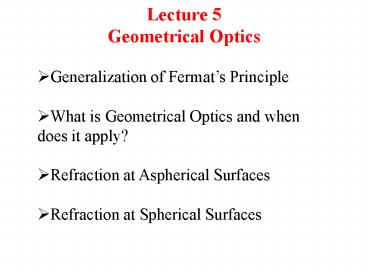Lecture 5 Geometrical Optics - PowerPoint PPT Presentation
1 / 14
Title:
Lecture 5 Geometrical Optics
Description:
What is Geometrical Optics and when does it apply? Refraction at Aspherical Surfaces ... Sytem is stigmatic for points S and P. S. Geometrical Optics. Limitation ... – PowerPoint PPT presentation
Number of Views:644
Avg rating:3.0/5.0
Title: Lecture 5 Geometrical Optics
1
Lecture 5Geometrical Optics
- Generalization of Fermats Principle
- What is Geometrical Optics and when does it
apply? - Refraction at Aspherical Surfaces
- Refraction at Spherical Surfaces
2
Generalization of Fermat Principle
- Fermat's principle of optics, in its historical
form states - The actual path between two points taken by
a beam of light is the one which is traversed in
the least time. - The modern, full version of Fermat's Principle
states - the optical path length must be extremal,
which means that it can be either minimal,
maximal or a point of inflection (a saddle point
Optical Path Length
3
Stationary Optical Path Length
- Examples when O.P.L is not minimal
- Point Source at focus of Ellipsoid
- Spherical Interface
- Lens
4
Fermats PrincipleEllipsoid
- Ellipsoid with observer at F2 and point source at
F1 - Distance F1-gtx-gtF2 constant for all paths that
reflect from ellipsoid surface - No path that is minimal!!!
- OPL for all of these paths are the same
- Each path is equally probable!!!
5
Fermats PrincipleRefraction at Spherical
interface for paraxial rays
- Plane interface where there was only one path
that minimized time - At spherical interface there are multiple paths
between A and B that have same OPL - These paths are equally probable
6
Fermats PrincipleLens
- All trajectories for light to travel from A to B
are equally probable
7
Geometrical Optics
- The study of how images form in optical systems.
- Uses the concept of rays
- Rays have direction and position but no phase
information. - Optics is an approximation of how Electromagnetic
Radiation behaves in an optical system - This model works well when the smallest dimension
of the optical system is much larger than the
wavelength of the incident EM Radiation. - Physical Optics must be used when the wavelength
is large - An object is viewed as a collection of many
pin-point sources that produce bundles of rays. - These rays are traced through an optical system
to determine what image will be formed.
8
Geometrical Optics
- Objects are point sources of Rays .
9
Geometrical Optics
- If rays emerging from point S are imaged into
same focal point P - S and P are conjugate focal points
- Sytem is stigmatic for points S and P
Point source of rays
Optical System
Focal point
S
10
Geometrical OpticsLimitation
If system accepts only segments of wave fronts ?
Waves will be diffracted Diffraction Limited As
l ? 0 no diffraction limit (More on this later)
11
Refraction at Aspherical Surfaces
- Refer to figure 5.3 of text
- Consider a point source at S
- Consider a material with index nt
- When nt is greater than ni , the wave slows
when entering medium - Extremeties of wavefront will overtake the
midregion - If interface is properly shaped the spherical
wavefront can be bent into a plane wave - Required shape can be found by finding shape
where any point A on the surface where the path
SAD will have the same phase where D lies on a
plane surface in the medium (draw this on
board). - Same phase ? same number of wavelengths for
whichever path from S to DD is taken
F1A/liAD/lt is constant - constant is the equation
for a hyperbola with eccentricity - Reversible
- http//www-optics.unine.ch/education/optics_tutori
als/aspherical_surface.html
12
Aspherical Surfaces
- To obtain object and image points that lie
outside of transparent medium use a second
interface with similar shape
- Apheric Optical Elements
- With one or both surfaces neither planar nor
spherical - Difficult to manufacture ? Expensive
- Surface Quality inferior to spherical optics
13
Refraction at Spherical Surfaces
Fermat?
- Refer to figure 5.6 of text
- Derive relationship between
on board - Paraxial Optics
- For rays that arrive at shallow angles w.r.t
optical axis
14
Geometrical Optics Java Applets
- http//www.phy.ntnu.edu.tw/oldjava/optics/mirror_e
.html - http//www.phy.ntnu.edu.tw/ntnujava/main.php?t65
- http//www.kamikawas.com/physics/thicklens/thicl_e
.htm































